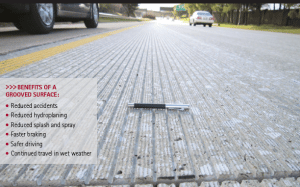>>>GROOVING ROADS DECREASES ACCIDENTS, SAVING LIVES<<<
Pavement Grooving Company NY – Why Grooving? Inclement weather – rain, snow and ice – always increases the risk of accidents and the loss of life. J.P. Hogan, understands automobile accidents tend to increase when there is a loss of friction between the tire and pavement surface due to slippery conditions. Highway departments have found that the best way to decrease accidents during inclement weather is to remove water from the surface and increase the traction between the tire and the road. Experience has shown that grooving a pavement’s surface is a very effective method to increase traction, reduce hydroplaning and minimize splash and spray as well as provide a more effective braking surface. This easily constructed and economical surface treatment provides the superior traction needed for vehicles to maintain control while driving in wet, dangerous conditions. Municipalities and departments of transportation world wide are finding that grooving has a two-fold benefit: it increases a driver’s safety while driving in wet conditions and at the same time, saves on the costs of replacing or overlaying the pavement surface.


>>HOW IS A SURFACE GROOVED?<<<
To groove a pavement surface, grooving machines equipped with circular diamond-tipped saw blades are used to saw grooves into the surface. The blades are mounted and spaced on a horizontal shaft and are cooled constantly by water pumped from a tanker which is then recovered by an on-board vacuum system. These discrete channels can be constructed transversely or longitudinally into both concrete and asphalt surfaces. Engineers typically specify grooves 1/8-inch to 3/16-inch deep and 1/8-inch wide.
The spacing is typically ¾-inch center-to-center although random spacing of blades is used at times when grooving transversely to control tire/pavement noise. A road’s surface texture can be lost through tire wear and by the action of abrasives, tire chains, salt, freezing and thawing.
Please go to IGGA.net for more information and detailed specification.



